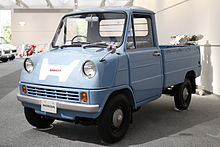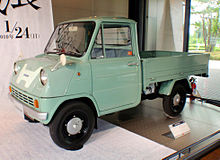Honda T360
The Honda T360 from 1962 was the first Honda small van, the T standing for mini truck and the number for the cubic capacity in cc . The vehicle had the type code AK250 and product code 500 + 548 + 562.
This van was first presented to the public on October 25, 1962 at the 9th Tokyo Motor Show , alongside the pre-production sports car model S360 and the S500 , Honda's first passenger car.
Development and introduction
The Japanese government, represented by MITI , decided in 1962 to pass a law that would give only three companies the rights to build automobiles.
The entire car development at Honda began in 1958 with a small group of 50 new employees who formed the first automotive development department. Yoshio Nakamura , who later became Formula 1 team manager, was the project manager for the Honda Sports and van series. In 1957, at the age of 39, he left Kurogane for Honda and became the 3rd Honda Research Department at Honda R&D. At first he was only assigned seven young engineers.
In October 1958 the first drafts were ready. On May 31, 1960, the first prototype XA-120 was completed and the first driving tests were carried out. It had a lengthways air-cooled 60-degree 4-cylinder V-engine . This test vehicle had only been designed for the first tests and had a semi- monocoque frame with a flat bottom. The bonnet and fenders were made of sheet metal and bolted on. The roof and the doors were made of plastic pieces and were clipped on.
On June 2, 1961, the 2X-120 was put on the road as a further prototype with the longitudinally air-cooled 60-degree V4 engine. Due to various restrictions of the air-cooled engine principle, this V4 cylinder engine was initially rejected as unsuitable. The air cooling had actually been Sōichirō Honda's favorite, but the engineers convinced him of the advantages of the water-cooled unit.
In the prototype 3X-120 in April 1962 and in the pre-production vehicle XAK-250 in June 1962, a longitudinal, water-cooled 360 cm³ four-cylinder engine (AK250E) was also used for the T360 van.
The T360 van (product code 500 + 548 + 562) was available in four versions. As T360F as a flatbed truck without walls but reinforced corner parts, T360H with foldable parts, as T360V with fixed platform wall and bow with tarpaulin or fixed structure. Another and very rare variant for snow operations was the T360 Crawler , which had a caterpillar drive instead of the rear wheels and was fitted with skids on the front wheels.
In August 1963 the press was able to undertake test drives on Honda's own Arakawa test track. The T360 came on the Japanese market in August 1963 and was built in Saitama (now Wako Plant), from April 1965 to November 1967 at the Sayama plant , a total of 108,920 units.
technology
The small, water-cooled 360 cm³ four-cylinder high-performance engine made of cast aluminum with two overhead camshafts ( DOHC ) was positioned lengthways at the front and inclined approx. 90 degrees to the left around the longitudinal axis in the engine compartment in order to allow a lower installation height under the driver's cab. Honda only used needle bearings for the bearings of the crankshaft and as the lower connecting rod bearings, which in addition to lower friction losses also resulted in fewer lubrication and cooling problems. With its effective 354 cm³ it produced 22 kW (30 hp) at 8,500 rpm. This resulted in an output per liter of 84.5 hp / l. The maximum torque was given as 2.7 mkp (26.5 Nm ) at 6,000 rpm. A separate Keihin carburetor with a throttle valve and vacuum-controlled slide was provided for each cylinder. The engine was accessible through the fold-up driver's seat, which enabled the cooling water, engine oil and transmission oil, ignition, alternator, carburetor and air filter to be checked.
The power was transmitted to a differential to the rear axle via a cardan shaft . The conventional rigid axle with differential was suspended from leaf springs and shock absorbers . The front wheels were suspended from wishbones with shock absorbers and coil springs. The deceleration was done by four drum brakes .
In the Japanese prospectus a maximum speed of 100 km / h was specified. The maximum load was given as 350 kg and the turning radius as 4.3 m. The dimensions were: L x W x H 2990 x 1295 x 1525 mm. The gas tank could hold 20 liters and the tires were 4.50-12.
The instruments were housed in a rectangular housing and consisted of a speedometer up to 80 mph, a cooling water thermometer, the fuel gauge and warning lights with symbols for indicators, battery charge level and handbrake. To the left of this were pressure switches for the windshield wipers, parking lights and driving lights. The van was only built with right-hand control.
With the length of the car of 2.99 m, the Japanese obligation to provide a parking space from 3 m in length was simply bypassed and thus reached a large group of buyers. This small delivery van was known as the kei car class in Japan in the 1960s .
Honda T500
The T500 (type code AK280 and product code 501) came onto the Japanese market in 1964 and the engine (AK280E) now had 38 hp at 7,500 rpm with an effective 531 cm³. The maximum torque was given as 4.3 mkp (42.2 Nm ) at 4,500 rpm. In the Japanese prospectus a maximum speed of 105 km / h was specified. The maximum load was 400 kg and the turning radius was 4.4 m, the dimensions: L × W × H 3190 × 1295 × 1545 mm. The gas tank could hold 20 liters and the tires were 4.50-12.
This T500 van (product code 501-503 + 563) was available in three versions. As T500F with folding platform walls , as T500 with fixed platform wall and bow with tarpaulin. Another and very rare variant for snow operations was the T500 Crawler , which had a caterpillar drive instead of the rear wheels and was fitted with skids on the front wheels. The T500 was built from 1964 to March 1965 at the Saitama plant (now Wako Plant), and from April 1965 to 1967 at the Sayama plant. Exactly 10,226 pieces of this type were produced and sold mainly in Japan and in very small numbers also in Australia.
Model overview
| Honda T360 prototype | Honda T360 | Honda T500 | |
| image |

|

|
|
|---|---|---|---|
| Technical specifications | |||
| engine | In-line four-cylinder four-stroke engine (light metal), water-cooled, DOHC , 4 Keihin horizontal throttle valve carburettors |
||
| Displacement | 356 cc | 354 cc | 531 cc |
| Bore × stroke | 49 × 47 mm | 49 × 47 mm | 54 × 58 mm |
| compression | 8.5: 1 | 8.5: 1 | 9.5: 1 |
| power | 30 horsepower at 8500 min -1 | 30 horsepower at 8600 min -1 | 38 hp at 7500 min -1 |
| Max. Torque ( SAE ) | 26.5 Nm at 6000 min -1 | 26.5 Nm at 6000 min -1 | 42.2 Nm at 4500 min -1 |
| body | Ladder frame with all-steel body | ||
| Front landing gear | Independent suspension with wishbone , strut , shock absorber , stabilizer | ||
| Rear landing gear | Rigid axle , trailing arm , suspension strut , leaf spring | ||
| Length × width × height (mm) | 2990 × 1292 × 1552 | 2990 × 1294 × 1555 | 3190 × 1295 × 1545 |
| Wheelbase (mm) | 2000 | 2000 | 2000 |
| Ground clearance (mm) | 160 | 160 | 150 |
| Standard tires | 4.5-12 4PR | 4.5-12 4 / 6PR | 4.5-12 4 / 8PR |
| Turning circle | 8.4 m | 8.6 m | 8.8 m |
| Empty weight | 550 kg | 610 kg | 640 kg |
| Payload | 350 kg | 350 kg | 400 kg |
| Top speed | 100 km / h | 100 km / h | 105 km / h |
| Acceleration 0-100 km / h | approx. 28 s | approx. 28 s | approx. 25 s |
| Tank capacity | 20 liters | 20 liters | 20 liters |
|
consumption
(Super Plus 98 RON ) |
5.88 l / 100 km at 90 km / h | 5.88 l / 100 km at 100 km / h | 5.55 l / 100 km at 100 km / h |
| colour | white + moss green G-3 + dark green | moss green G-3 + light blue PB-31 | moss green G-3 + light blue PB-31 |
| Factory price | not on sale | 299,000-349,000 yen
(Japan only) |
325,000-374,000 yen
(Japan) |
| Production time | 1961-1963 | 1963-1967 | 1964-1967 |
| production
(Number of pieces) |
approx 8 | 108,920 | 10,226 |
successor
The T360 was replaced by the TN360 (product code 567) in 1967 . This now had the air-cooled two-cylinder, similar to that of the N360 sedan. With an effective 354 cm³ it now had 30 hp at 8,000 rpm. The maximum torque was given as 3 mkp (29.4 Nm ) at 5,500 rpm. The Japanese prospectus stated a top speed of 100 km / h (62 mph). The maximum payload was 350 kg and the turning circle 8 m, the dimensions: L × W × H 2990 × 1295 × 1625 mm. The petrol tank could hold 26 liters and the tires were 5.00-10.
Individual evidence
- ↑ HONDA AUTOMOBILE from 1988, page 32

